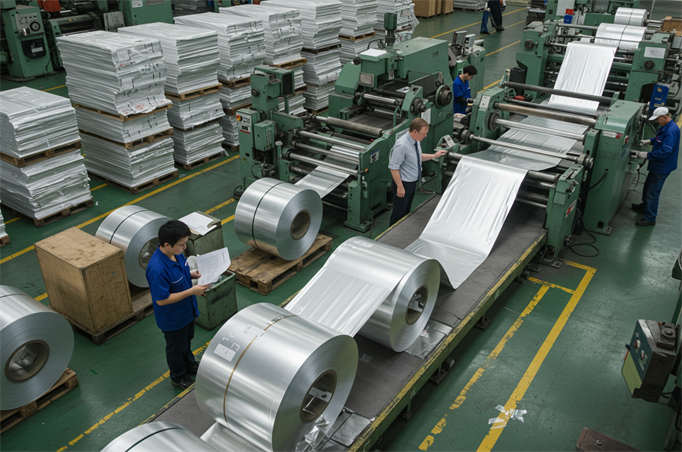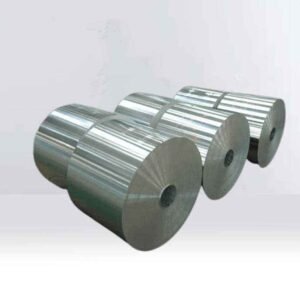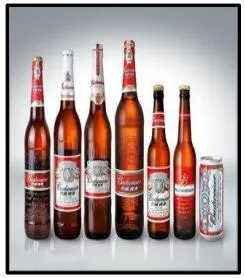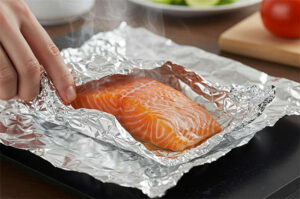At Yutwin Aluminum Foil, innovation and sustainability go hand in hand. As a leading manufacturer of heavy-duty aluminum foil, we are committed to delivering high-performance materials that meet the evolving demands of industries ranging from automotive and renewable energy to food packaging and innovative technology. Heavy-duty aluminum foil has become a cornerstone of modern manufacturing with its exceptional strength, thermal resistance, and barrier properties. Whether enhancing battery efficiency, enabling lightweight automotive designs, or ensuring food safety, our products are designed to excel in performance while supporting global sustainability goals.
In this blog, we delve into the transformative potential of heavy-duty aluminum foil across emerging applications, from next-generation battery technologies to eco-friendly construction materials. We explore how advancements in material science, regulatory support, and market demand drive the adoption of aluminum foil in sectors like aerospace, hydrogen energy, and innovative packaging. As we navigate the challenges of climate change and resource scarcity, Yutwin Aluminum Foil is proud to contribute to a greener, more efficient future—one sheet of foil at a time.
Definition and Classification of Heavy Duty Aluminum Foil
Thickness Range
Heavy duty aluminum foil typically refers to products with a thickness ranging from 0.01 to 0.2 mm, which are among the thicker specifications in industrial aluminum foil. According to national standards (GB/T 3198), it is classified into single foil (>0.012 mm) and double foil (≤0.012 mm), with heavy duty aluminum foil being preferred in high-strength, high-sealing applications.
Material and Alloys
Common materials include 8011, 1235, and 8079 aluminum alloys, which are known for excellent ductility, corrosion resistance, and high-temperature resistance. For instance, 8011 alloy, with its high purity (≥99.8%) and food-grade safety, is widely used in food packaging.
Key Applications of Heavy Duty Aluminum Foil
Food and Pharmaceutical Packaging
Due to its high barrier properties (oxygen, water vapor, and light resistance), heavy-duty aluminum foil has become the go-to material for food preservation and pharmaceutical moisture protection. It используется for packaging baked goods and frozen foods and the sealing layer of blister packs for medications.
Industrial and New Energy
- Battery Manufacturing: Used as the positive electrode collector in lithium-ion batteries, with a thickness between 10-50 microns, it demands high conductivity and tensile strength.
- Electronic Components: Applied in capacitor electrodes, requiring high-purity aluminum (≥99.93%) and solvent resistance, ideal for high-voltage environments.
- Heat Sealing and Sealing: For example, the Azenta 4titude aluminum foil heat seal film, resistant to high temperatures (-200°C to 110°C), is suitable for long-term storage and transportation in labs.
Construction and Automotive
Used as insulation reflective materials in buildings and for engine heat insulation and battery protection in the automotive sector, capitalizing on its lightweight and high-temperature resistance properties.
Advantages of Heavy Duty Aluminum Foil
Moisture Resistance and Barrier Properties
Aluminum foil with a thickness of ≥0.015 mm has almost zero moisture permeability, effectively preventing oxidation and microbial growth, making it ideal for long-term storage.
High-Temperature and Mechanical Strength
Heavy-duty aluminum foil withstands high-temperature processing (e.g., ovens, sterilization). Full-hard foil (H18/H19) can achieve tensile strength ranging from 140 to 265 MPa, making it suitable for high-strength packaging.
Environmental and Recyclable
Aluminum foil is 100% recyclable, aligning with the green packaging trend. Production processes can be optimized to reduce carbon emissions.
Production Standards and Market Status
National Standards
China leads the global aluminum foil production, reaching 5.1 million tons in 2023, with packaging aluminum foil accounting for 50%. Industrial aluminum foil must meet the thickness, surface finish, and chemical composition requirements specified in GB/T 3198.
Major heavy duty aluminum foil Manufacturers
Key domestic players include Ding Sheng New Materials and Chang Aluminum Co., which cover the food, electronics, and new energy sectors and have a significant export share.
Услуги по настройке
We offer customized solutions for logo printing in widths (300-2200mm) and lengths (3-500m), with a minimum order quantity of usually 1000-3000 rolls.
Selection and Usage Recommendations
Thickness Selection Based on Application
- Standard Home Use: 10-15 microns (for baking and small packaging).
- Grilling/High-Temperature: 18-25 microns (for whole chicken, steaks).
- Industrial Sealing: ≥25 microns (for solvent resistance and long-term storage).
Certifications and Safety
Food-grade aluminum foil must comply with CE certification, while pharmaceutical packaging requires additional alkali resistance and sterile testing.
Heavy Duty Aluminum Foil’s Prospects in Automotive Manufacturing
Heavy duty aluminum foil (0.01-0.2 mm thickness) holds great potential in the automotive industry, especially with the growing demand for new energy vehicles, lightweight technologies, and green manufacturing trends. Here is a detailed analysis:
Core Applications in New Energy Power Batteries
Lithium Battery Positive Electrode Collector
As the positive electrode collector in lithium-ion batteries, heavy duty aluminum foil directly impacts battery energy density and safety. China’s aluminum foil production for batteries accounted for a significant portion of global capacity in 2023, with an estimated global demand of 350kt/a by 2025, 65% of which will come from China. Composite aluminum foil (aluminum-PET/PP sandwich structure) reduces battery weight and enhances energy density, already applied in models like the Zeekr 009 and BYD vehicles, with mass production expected after 2025.
Solid-State Battery Packaging
Aluminum foil’s high sealing and temperature resistance (-200°C to 110°C) make it ideal for packaging solid-state batteries, ensuring stability in extreme environments. Companies like Tesla and BYD are optimizing battery structures with aluminum foil to enhance rigidity and safety.
Sodium-Ion Batteries and Energy Storage Systems
Sodium-ion batteries also require aluminum foil for positive and negative electrodes, with usage expected to rise by 40% over lithium batteries. The demand for aluminum foil in grid-level energy storage and home energy systems is set to increase significantly.
Lightweight Car Bodies and Structural Components
Whole Aluminum Car Bodies and Panels
Automakers like Audi and Tesla Model S have adopted full aluminum car bodies, achieving a weight reduction of 30% to 40%, which in turn improves battery range by 10%. Nanning’s aluminum deep processing capacity exceeds 1 million tons, supporting the lightweight of automotive body and chassis components.
Battery Trays and Chassis Components
Aluminum alloy battery trays are the largest aluminum structural components in new energy vehicles, requiring both lightweight and strength. Companies like Nanshan Aluminum use 6061-T6 alloy extruded profiles to meet these high-strength demands.
Thermal Management and Protection Systems
Battery Thermal Management Systems
Алюминиевая фольга используется in heat sinks and conduits to enhance battery pack thermal efficiency. Companies like CATL optimize battery module heat management with aluminum foil, reducing the risk of thermal runaway.
Engine Heat Insulation and Electromagnetic Shielding
Aluminum foil’s high thermal conductivity and electromagnetic shielding properties enhance vehicle safety and reliability. It is used in engine compartment heat insulation layers and electronic device protection.
Technological Innovations and Environmental Trends
Composite Aluminum Foil Technology Breakthrough
Composite aluminum foil achieves high conductivity through vapor deposition technology, offering significant cost advantages. The market for this technology is expected to reach 24 billion RMB by 2026, with primary applications in high-energy-density sectors.
Green Recycling and Circular Economy
Aluminum foil is 100% recyclable, and advancements in recycling technologies are driving low-carbon manufacturing. For example, Lantu Automotive’s use of recycled aluminum reduces vehicle weight by 15%, cutting carbon emissions equivalent to planting 14 full-grown trees.
Smart Production Processes
Technologies like servo presses and vacuum suction transfer systems enhance aluminum foil production efficiency and precision. Companies like Wangi Aluminum have scaled up high-end foil production, reaching a monthly output of over 600 tons.
Policies and Market Drivers
Policy Support
China’s “Non-ferrous Metals Industry Stability and Growth Plan“ encourages the application of aluminum foil in new energy and lightweight sectors, with cities like Nanning creating international aluminum processing hubs.
Market Demand Growth
China’s new energy vehicle sales grew 1.8 times in 2023, driving a surge in aluminum foil demand. By 2025, the use of high-end aluminum plates in automobiles is expected to exceed 1 million tons, with the penetration of composite aluminum foil rising.
Challenges and Future Directions
Technological Bottlenecks
Controlling impurities from non-aluminum elements (such as Fe and Si) and overcoming the complexity of manufacturing processes remains challenging. To improve material performance, it is crucial to develop dispersion-strengthened precipitates.
Cost Control
Aluminum price fluctuations impact profit margins. Cost reduction can be achieved through large-scale production and process optimization.
International Competition
European and American companies are rapidly advancing in solid-state battery and composite aluminum foil technologies. Domestic companies need to strengthen their R&D and patent strategies.
New Application Fields for Heavy Duty Aluminum Foil in the Future
Heavy duty aluminum foil (0.01-0.2 mm thickness), with its high strength, high barrier properties, corrosion resistance, and lightweight features, has vast potential in emerging fields. Below are potential new applications and technological directions:
New Energy Batteries and Storage Systems
Composite Collector Technology
Composite aluminum foil (aluminum-PET/PP-aluminum sandwich structure) enhances energy density and safety in lithium batteries. This lightweight design reduces battery weight, and the vapor deposition process improves conductivity. It is already applied in vehicles like Zeekr 009 and Wuling M9, with mass production expected post-2025.
Sodium-Ion Batteries
Aluminum foil usage for sodium-ion battery electrodes will increase by about 40%, supporting growing energy storage needs, particularly in grid-level and home storage systems.
Solid-State Battery Packaging
Aluminum foil’s high Sealing and temperature resistance make it ideal for solid-state battery packaging, ensuring stability in extreme environments.
Aerospace and High-End Equipment
Lightweight Structural Materials
Heavy-duty aluminum foil, with a honeycomb structure providing high strength and lightweight characteristics while also offering electromagnetic shielding and radiation resistance, is used in aircraft skins and satellite insulation layers.
Thermal Management Systems
Aluminum foil enhances thermal conductivity in heat pipes and heat sinks for aerospace electronics, improving reliability.
Smart Home and IoT Devices
Flexible Electronics
Aluminum foil tape is used in smart home sensors for electromagnetic shielding and grounding protection, as well as circuit board protection for smart appliances and flexible circuit substrates for wearable devices.
Smart Packaging Integration
With RFID tags or temperature-sensitive coatings, aluminum foil packaging monitors food freshness or pharmaceutical storage conditions, ideal for cold chain logistics and innovative healthcare applications.
Hydrogen Energy and Clean Technology
Hydrogen Fuel Cell Components
Aluminum foil enhances corrosion resistance and conductivity in the bipolar plates of hydrogen fuel cells. It also serves as a barrier layer in hydrogen storage tanks, preventing leakage.
Electrolyzer for Hydrogen Production
High-purity aluminum foil is an electrolyzer electrode material, optimizing hydrogen production efficiency and extending equipment lifespan.
Eco-Friendly Construction and Green Engineering
Low-Carbon Building Materials
Aluminum foil composite insulation panels используются in building facades to reduce energy consumption by reflecting heat radiation. Aluminum foil membranes also serve as waterproofing layers in photovoltaic rooftops, enhancing solar panel efficiency.
Circular Economy Applications
Recycled aluminum foil from food containers and construction waste will replace plastic products in low-carbon city construction and significant events like the Olympics, reducing white pollution.
3D Printing and Custom Manufacturing
Metal Additive Manufacturing
Heavy duty aluminum foil powder is used in 3D printing aerospace components, where nano-coating technology enhances strength and reduces processing costs.
Custom Industrial Molds
Aluminum foil is used in hot-press molding to create complex industrial molds, which are ideal for small-batch, high-precision production.
Policy and Market Drivers
Policy Support
China’s “Non-ferrous Metals Industry Stability and Growth Plan“ encourages using aluminum foil in food-grade packaging, driving its application in ready meals and cold chain logistics.
Technological Upgrades
Innovative production processes (e.g., AI inspection, IoT devices) improve the precision and efficiency of aluminum foil production, reducing the cost of high-end products like high-pressure anode foils.
In the future, heavy duty aluminum foil will play a critical role in new energy, high-end manufacturing, innovative technology, and green economies. Technological breakthroughs and policy guidance will continue to push its development toward high-performance, customized, and sustainable applications.

The future of heavy-duty aluminum foil is brighter than ever. This versatile material redefines what’s possible, from its critical role in powering electric vehicles and renewable energy systems to its innovative use in smart homes and green construction. At Yutwin Aluminum Foil, we are not just manufacturers but partners in progress. Our state-of-the-art production facilities and commitment to R&D ensure that our aluminum foil solutions remain at the forefront of technological advancement, sustainability, and cost-efficiency.
Whether you’re a manufacturer seeking high-performance materials, a policymaker advocating for greener industries, or a consumer looking for eco-friendly packaging, Yutwin Aluminum Foil is ready to support your vision. We invite you to explore our range of heavy-duty aluminum foil products, tailored to meet your specific needs with precision and reliability. Contact us today to learn how our solutions can elevate your projects and contribute to a sustainable tomorrow. Let’s shape the future together—one innovative application at a time.





























